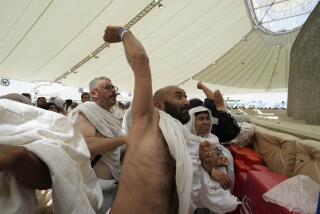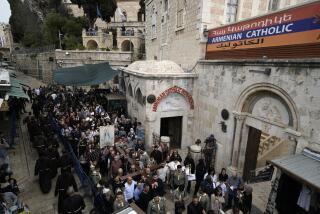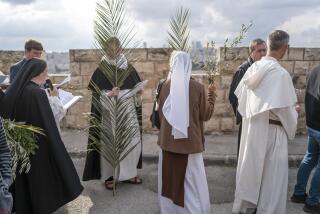Route of Pilgrims : ‘Way of the Cross’ May Be Off Track
- Share via
JERUSALEM — It is a scene that has been repeated each Friday afternoon for centuries in Jerusalem’s walled Old City.
Christian pilgrims by the score struggle to stay together as they elbow their way through crowds of shoppers in the narrow stone streets. Some of them carry symbolic wooden crosses, but these days more of them carry cameras as they follow the “Via Dolorosa”--”The Way of the Cross.”
It is, according to a fairly typical Jerusalem guidebook, “Christendom’s most sacred road,” following what tradition holds to be the route that Jesus Christ took from the place where he was condemned to death by the Roman procurator Pontius Pilate to the hill of Golgotha, also known as Calvary, where he was crucified nearly 2,000 years ago and buried in a nearby sepulcher.
Going the Wrong Way
As a Roman Catholic priest of the Dominican order, Father Jerry Murphy-O’Connor can only praise the devotion of these pilgrims who go to such lengths to memorialize the suffering of the Man and God that they worship as their spiritual savior. But as a scholar and expert on the historical geography of Jerusalem at the oldest Roman Catholic graduate school in the Holy Land, he has a different view:
If they’re trying to walk in the footsteps of Jesus, he says, the pilgrims are going the wrong way.
The traditional route, Murphy-O’Connor explained in an interview conducted in the streets of the Old City, begins near the city’s eastern edge, at the place where the Antonia Fortress--renamed by King Herod the Great after his Roman patron, Marc Antony--once stood. According to tradition, this is the place where Pilate condemned Jesus to death.
Actual Route in Doubt
What is much more likely, the Irish priest said, is that Pilate judged Jesus from a platform in front of what had been Herod’s palace, which was located near the Jaffa Gate on the western extremity of the Old City. That would mean that Jesus had to take a totally different route to the site of the Crucifixion and burial, now marked by the Christian Church of the Holy Sepulchre.
From a devotional point of view, Murphy-O’Connor stressed, it’s “completely irrelevant” that the traditional route is in the wrong direction.
“It’s the same sort of experience for a pilgrim whether he comes from east to west or west to east,” he said.
However, he added, “If you’re talking for the record or you’re talking historically, then I think you have to say as close to the truth as you can get at the moment.”
The truth is that there is no hard archeological evidence to support either route, said Murphy-O’Connor, who has lived in and studied Jerusalem ever since he came here as a graduate student 25 years ago. And tradition has varied through the centuries.
“The whole question is: ‘Where was Pilate?’ ” said the priest, who is now a professor of historical geography at Jerusalem’s Ecole Biblique and author of “The Holy Land: An Archeological Guide.”
But based on historical records about the customs of the time, Murphy-O’Connor said Pilate must have been at the palace, which served as the residence of the Roman procurators when they traveled to Jerusalem from their normal headquarters in Caesarea, on the Mediterranean coast.
The practice symbolized “the transition from the local power to Roman power,” he explained.
Details ‘Prettied Up’
The popular route from the Antonia Fortress may have its roots in another devotional parade that dates from the 5th or 6th Century, the historian speculated. That procession started at what is said to be the Garden of Gethsemane, to the east of Jerusalem, through that side of the city to the Church of the Holy Sepulchre.
Jesus’ route through the Old City is not the only aspect of the Crucifixion where history and archeology are in conflict with devotional tradition, Murphy-O’Connor said. While there is nothing implausible about the general story of the Crucifixion, he added, some of the details have apparently been “prettied up to make it more palatable to conservative-minded Christians.”
Murphy-O’Connor explained: “The problem with the Way of the Cross is that as you very often see it represented, especially in Catholic churches, you have a Jesus who is absolutely impeccable: His hair perfectly cut and combed, his beard perfectly trimmed, not a stain on any of his garments. He has a dinky little cross slung over his shoulder and he’s sauntering along. But this, I think, is part of the dominant Catholic attitude to avoid any contact with the reality of the humanity of Jesus.”
The reality, the priest noted, was much more grim than this common depiction. It is known, for example, that historically those condemned to crucifixion had a wooden beam strapped to their outstretched arms.
‘Conceived as Torture’
“What that means is you can’t walk down this sort of street,” he said, indicating one of the Old City’s typically narrow passageways. “All you can do is shuffle sideways.”
It was “part of the game” for bystanders along the route to strike at the victim’s kidneys and genitals, and since the prisoner was struggling along sideways, he was unable to see potholes or steps in the route. With his arms strapped to the cross-beam, he could not protect his face when he fell.
“This was really conceived as torture,” Murphy-O’Connor noted.
Nor was Calvary, he said, the lonely hilltop that it is so often depicted as, but a stone outcropping at the corner of an abandoned rock quarry.
It was European Christians, who had devised their own “Way of the Cross” devotions at home, who brought to Jerusalem the tradition of 14 “stations” or stops along the route, Murphy-O’Connor said. The Via Dolorosa at the time had only seven.
New Stations Were Added
But even in the 15th Century, he said with a laugh, “Jerusalem would do anything to keep tourists happy.” New stations were added, so that today the route includes 14.
Whether the events traditionally depicted at each station actually occurred is sheer speculation, he said.
“You don’t get every station in every Gospel,” the priest explained. “So you’re putting together four different accounts. I mean, Jesus may only have fallen once, but three Gospels say it. So you get three falls. That’s the problem.”
Modern tourists are frequently put off by what they see as the extraordinary commercialism attached to religious sites in Jerusalem. A “Fifth Station Souvenir Shop” along the Via Dolorosa, for example, sells T-shirts as well as religious mementos.
But Murphy-O’Connor noted that Christianity has been commercialized here “right from the beginning.” The city’s entire Armenian quarter, for instance, was built in medieval times just to cater to pilgrims.
History of Commercialism
Commercialism has its historical value, the Irish priest added. For example, what is believed to have been the original tomb of Christ was destroyed by an Egyptian conqueror in 1009, and it is only because of early commercialism that it is known what that tomb looked like.
“Pilgrims of the 6th Century brought back to Europe oil from the sacred lamps and water from the Jordan in little silver flasks, about six inches in diameter” and the flasks were etched with a tiny replica of the tomb, Murphy-O’Connor said. Some are still preserved.
Also, those early visitors “were able to buy in Jerusalem stone models of the tomb, and a lot of them are floating around Europe. That’s how, archeologically, we can reconstruct what the tomb looked like at the time of Christ.”
Unfortunately, Murphy-O’Connor pointed out, the current replica of the tomb on display in the Church of the Holy Sepulchre is much larger and more garish than the original.
“Admirers of the (current) tomb call it a hideous kiosk, which is a very accurate description,” said the priest-historian.
More to Read
Sign up for The Wild
We’ll help you find the best places to hike, bike and run, as well as the perfect silent spots for meditation and yoga.
You may occasionally receive promotional content from the Los Angeles Times.






